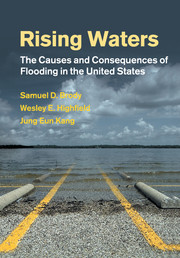Book contents
- Frontmatter
- Contents
- Preface
- Acknowledgments
- Abbreviations
- 1 Introduction: rising waters
- Part I The consequences of floods
- Part II Planning decisions and flood attenuation
- Part III What are we learning?
- 9 Policy learning for local flood mitigation
- 10 Local case studies in Texas and Florida
- Part IV Policy implications and recommendations
- 12 Conclusions
- References
- Index
10 - Local case studies in Texas and Florida
from Part III - What are we learning?
Published online by Cambridge University Press: 28 April 2011
- Frontmatter
- Contents
- Preface
- Acknowledgments
- Abbreviations
- 1 Introduction: rising waters
- Part I The consequences of floods
- Part II Planning decisions and flood attenuation
- Part III What are we learning?
- 9 Policy learning for local flood mitigation
- 10 Local case studies in Texas and Florida
- Part IV Policy implications and recommendations
- 12 Conclusions
- References
- Index
Summary
Up to this point our study has been conducted largely at a “high altitude,” drawing conclusions across multiple jurisdictions at broad spatial scales. Studies of this kind are important because they allow us to make generalizations (in this case at state levels) that can inform a larger body of decision makers. So far, we have also offered quantitative empirical evidence on the causes and consequences of flooding among localities in the U.S., which is often absent in the scholarly and technical literature. What we miss, however, is a fine-grained, qualitative assessment of activity within specific communities. Unraveling the intricate socioeconomic, political, and environmental characteristics influencing a locality's decisions related to flood mitigation can lead to explanations that more comprehensive studies may miss.
To supplement our findings based on large-sample analyses and statistical models, we select five local jurisdictions: Galveston County, Texas; Freeport, Texas; Manatee County, Florida; St. Petersburg, Florida; and Palm Beach Gardens, Florida (see Figure 10.1), and provide a more detailed, integrated description of what is taking place in terms of coping with chronic floods. We selected these localities based on their variation in flood losses and mitigation policies, as well as on diversity in local conditions. These “profiles” include physical, socioeconomic, and policy-based contextual characteristics that exemplify the themes presented in previous chapters. The cases also provide an opportunity to explore how multiple factors come together to form an overall picture of flood impacts and mitigation responses.
- Type
- Chapter
- Information
- Rising WatersThe Causes and Consequences of Flooding in the United States, pp. 157 - 170Publisher: Cambridge University PressPrint publication year: 2011



